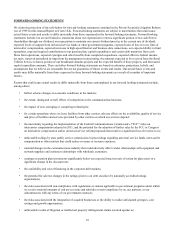Windstream 2012 Annual Report Download - page 75
Download and view the complete annual report
Please find page 75 of the 2012 Windstream annual report below. You can navigate through the pages in the report by either clicking on the pages listed below, or by using the keyword search tool below to find specific information within the annual report.13
customers. This could adversely affect our ability to compete for business customers, which, in turn, would adversely affect our
results of operations and financial condition.
New technologies may affect our ability to compete in our consumer markets.
Wireless companies are aggressively developing networks using next-generation data technologies, which are capable of
delivering high-speed Internet service via wireless technology to a large geographic footprint. If these technologies continue to
expand in availability and reliability, they could become an effective alternative to our high-speed Internet services. In addition,
cable operators may be able to take advantage of certain technology to deploy faster broadband speeds more rapidly than
Windstream.
In addition to broadband technology, evolving voice technologies, such as Voice over Internet Protocol ("VoIP"), may
effectively compete with voice and long-distance services in our consumer markets.
These and other new and evolving technologies could result in greater competition for our voice and high-speed Internet
services. If we cannot develop new services and products to keep pace with technological advances, or if such services and
products are not widely embraced by our customers, our results of operations could be adversely affected.
In certain operating territories, we are dependent on other carriers to provide facilities which we use to provide service to
our customers.
In certain markets, especially where we provide services to businesses, we lease a significant portion of our network capacity
from other carriers. These carriers compete directly with us for customers.
The prices for network capacity are negotiated or purchased pursuant to tariff terms and conditions. These may be changed but
must be approved by the appropriate regulatory agency before they go into effect. In addition, whenever we enter a new
market, and an existing agreement expires, interconnection agreements must be negotiated. If they cannot be negotiated on
favorable terms, or at all, we may invoke binding arbitration by state regulatory agencies. This process is expensive and time
consuming, and the results of arbitration may be unfavorable to us. The inability to obtain interconnection on favorable terms
could have a material adverse effect on our competitive position and results of operations.
Where we lease network capacity, communications services are susceptible to changes in the availability and pricing of the
provider's facilities and services. If the provider becomes legally entitled to deny or limit access to capacity, or if state
commissions allow them to increase their rates, we may not be able to effectively compete. In addition, if the provider does not
adequately maintain or timely install these facilities, which they are legally obligated to do, our service to customers may be
adversely affected. As a result, our results of operations and financial condition could be materially affected.
Disruptions and congestion in our networks and infrastructure may cause us to lose customers and incur additional
expenses.
Our customers depend on reliable service over our network. Some of the risks to our network infrastructure include physical
damage to lines, security breaches, capacity limitations, power surges or outages, software defects and disruptions beyond our
control, such as natural disasters and acts of terrorism. From time to time in the ordinary course of business, we will experience
short disruptions in our service due to factors such as cable damage, inclement weather and service failures of our third party
service providers. Additionally, we could face disruptions due to capacity limitations as a result of changes in our customers'
high speed Internet usage patterns. These patterns have changed in recent years, for example through the increased usage of
video, resulting in a significant increase in the utilization of our network.
We could experience more significant disruptions in the future. Disruptions may cause interruptions in service or reduced
capacity for customers, either of which could cause us to lose customers or incur additional expenses or capital expenditures.
Such results could adversely affect our results of operations and financial condition.
Disruptions in our data centers could cause service interruptions for customers using advanced data services.
Many of our advanced data products are supported by our data center infrastructure, including offerings such as colocation
services, cloud computing, managed services and disaster recovery services. Risks to our data center infrastructure include, but
are not limited to, natural disasters, security breaches or acts of terrorism.
























